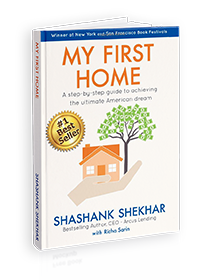HomeReady™ Program Will Offer 3% Down Payment On Conforming Loans
Author bio section
I am the author of this blog and also a top-producing Loan Officer and CEO of InstaMortgage Inc, the fastest-growing mortgage company in America. All the advice is based on my experience of helping thousands of homebuyers and homeowners. We are a mortgage company and will help you with all your mortgage needs. Unlike lead generation websites, we do not sell your information to multiple lenders or third-party companies.

Fannie Mae Announces New Low Down Payment Mortgage Product
Fannie Mae made big news this week when they announced a new mortgage product designed for low to middle income borrowers. The move officially retired the MyCommunity mortgage that had been a mainstay Fannie Mae product for years.
Fannie Mae’s announcement of the HomeReady™ mortgage, an innovative lending option aimed at helping creditworthy borrowers with lower and moderate incomes, has been greeted by mortgage lenders with much anticipation and provides a viable – and possibly more affordable – alternative to low-down payment FHA financing.
Get PreApproved for HomeReady Mortgage
How good of an alternative the loan proves to be to FHA financing will depend on each borrower’s unique situation and remains to be seen.
That said, one HUGE aspect of the new HomeReady program guidelines will have a crystal clear positive effect and will change the mortgage financing landscape in a big way.
For the first time ever, income from a non-borrower household member can be considered to determine an applicable debt-to-income ratio for the loan.
Yes, you read that right and you can be assured it is as massive news as you think it is. That is especially true for families in high cost areas of California like San Jose, Fremont, San Francisco, Los Angeles and San Diego.
Multi-generational and extended households now have an affordable mortgage that the can actually qualify to receive and that is a game-changer.
Why Such a Huge Underwriting Guideline Shift?
Fannie Mae’s extensive research indicates that these extended households tend to have stable incomes that often are more secure than smaller households at similar income levels.
Other HomeReady flexibilities include allowing income from non-occupant borrowers, such as parents, and rental payments, such as from a basement apartment, to augment the borrower’s qualifying income.
In the past, many of those income sources were not allowed at all OR they were excessively documented to the point they might as well have been disallowed.
Get Pre-Approved For Buying A Home
What Other Guidelines Should We Know?
First-time and repeat homebuyers can purchase a home using HomeReady with a down payment of as little as 3%.
Fannie Mae’s press release states:
The new HomeReady™ mortgage loan is designed to help lenders confidently serve today’s market of creditworthy, low- to moderate-income borrowers, with expanded eligibility for financing homes in designated low-income, minority, and disaster-impacted communities
HomeReady allows for one- to four-unit principal residence purchase, construction, or limited cash-out transactions. HomeReady will be permitted on all property types and also with HomeStyle® Renovation mortgages.
Allowing HomeReady borrowers to use the new product in conjunction with a HomeStyle Renovation loan is huge for buyers with limited assets.
HomeReady high-balance mortgage loans will be subject to standard loan-to-value guidelines. This means a minimum 5% down payment will be required for loan amounts exceeding $417,000.
Borrower income limits will apply the following income guidelines for HomeReady loan casefile eligibility:
- No income limits for properties located in low-income census tracts 100% of area median income (AMI) for properties located in high-minority census tracts or designated disaster areas.
- Non-occupant borrowers are allowed on HomeReady loans, and will consider the income and liabilities of all borrowers when determining the debt-to-income ratio used for qualifying.
- HomeReady loans with a non-occupant borrower(s) will be subject to standard LTV, CLTV, and HCLTV guidelines (LTV not to exceed 95%, CLTV ratio may exceed 95% on fixed-rate mortgages that are not secured by a manufactured home).
- While occupant borrowers may not have an ownership in any other residential property at the time of loan closing, non-occupant borrowers will be permitted to own other residential properties on HomeReady transactions
- HomeReady financing requires a homebuyer education course to be completed. To facilitate Fannie Mae has partnered with Framework to offer mobile-ready, online courses with 24/7 accessibility
Framework’s comprehensive course meets the requirements of HUD’s housing counseling program among other industry standard programs.
The course takes about 4 hours to complete and Framework charges a one-time $75 fee (for both you and a co-borrower),
Get PreApproved to buy a Home
What is the PMI coverage for HomeReady?
Another question often posed on speciality mortgage loans in excess of 80% loan-to-value, is how does the private mortgage insurance (PMI) work?
Standard MI coverage will be required on HomeReady loans with LTVs at or below 90 percent, and 25 percent coverage will be required for LTVs exceeding 90 percent, which is lower than Fannie Mae’s standard current MI coverage levels.
Previously, Fannie Mae used 30% coverage for MI purchased on loans at 90-95% LTV.
Conclusion
Fannie’s new HomeReady mortgage loan option will not only aid borrowers that do not fit into the standard underwriting guideline box, but it will also create business opportunities for lenders serving the changing demographics and borrower needs in today’s market.
The combination of our risk management safeguards and an innovative online education tool will put HomeReady borrowers in a strong position to succeed in homeownership and HomeReady should provide strong benefit to the overall housing market.
Download our Free Ebook – How To Buy Your First Home






